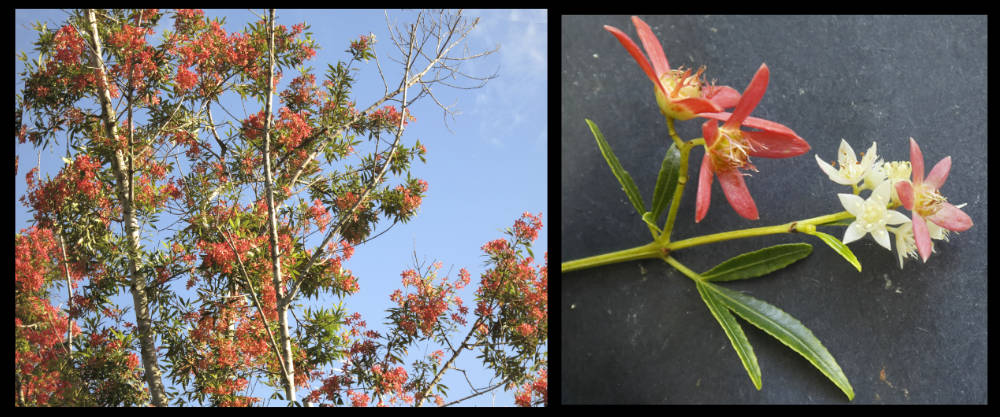Ceratopetalum.
There are 8 (Mabberley) or 9 (Kew) species from Australia and New Guinea.
Only 2 species are commonly seen – Ceratopetalum apetalum and C. gummiferum both found in
S.E. Queensland and adjacent areas of N.S.W.
Ceratopetalum are evergreen shrubs or trees up to 20 or 30 m high.
The brown or grey bark becomes fissured or flakes.
The foliage can be sparse to dense.
The opposite and decussate leaves, on a petiole have 1 to 3 leaflets.
The small leafy stipules, between the petiole bases leave a scar when they fall.
The ovate terminal leaflet is up to 20 cm long and 8 cm wide.
The edges have small rounded teeth (crenate).
Inflorescences are terminal or in the near terminal leaf axils.
They have many branches with bracts at the base of each.
The bisexual flowers are on a short or no stalk.
There are 4 to 6 white sepals with their bases fused.
Sepal lobes are mostly obovate but can be ovate, lanceolate or oblong.
The tip can be round or pointed and the base may or may not be narrowed.
As the fruit develop the sepal lobes enlarge, redden and become hard and woody.
On the fruit they are referred to as wings and can be up to 2 cm long.
There may be no petals or 4 or 5 small white ones each with 3 to 5 deep lobes.
Petals may fall off or remain on the fruit.
The swollen red calyx is the most prominent feature as it can last for weeks.
There are 8 or 10 stamens with small anthers that have an appendage from the connective between the pollen sacs.
Stamens may remain on the fruit.
There is always a nectary disc at the base of the stamens.
The part inferior ovary, up to 7 mm across has 2 locules each with 4 ovules.
The fruit is a nut – hard, dry and indehiscent with usually only 1 seed.
It is surrounded by the enlarged and bright red calyx with the 4 to 6 hard wings.
Ceratopetalum gummiferum has leaves with 3 leaflets and C. apetalum has leaves that appear to have only 1 leaflet.
J.F.


